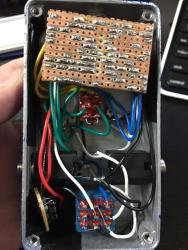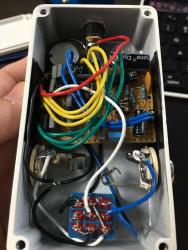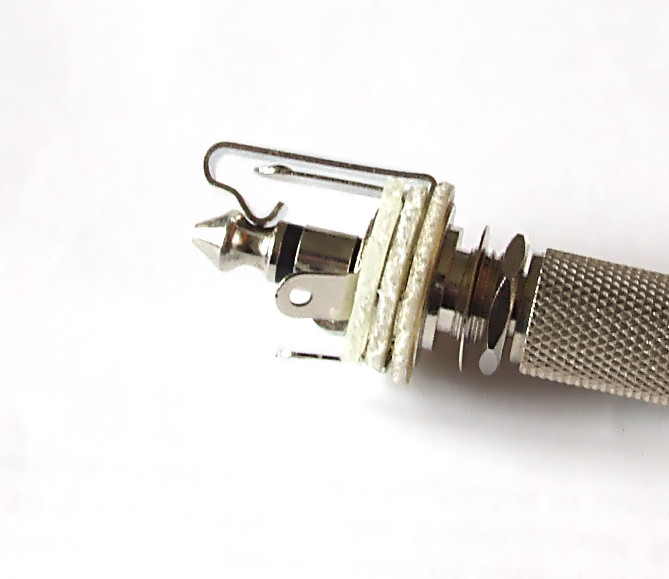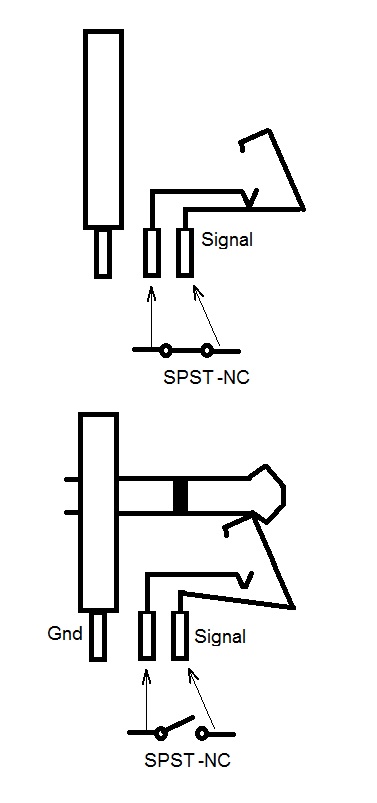Help understanding hum removal techniques.
12












12
Help understanding hum removal techniques.
|
The hum is real! And its driving me crazy. Please help!
Here is where I am at. I have 5 different pedals on my board, all made from layouts on this site. Individually, they are all great, with only slight hum that is tolerable. However, when I stack them, the hum becomes unmanageable. I did some research and I have tried a few things. Specifically, I redid the ground within each pedal to utilize the star grounding principle where possible. I also ditched my Onespot daisy chain and replaced it with an 8 output isolated power supply, the BBE Supercharger. These changes made only a slight difference, but not enough to fix the issue. Further research has led me to a few other things to try, but I don't quite understand them all. Can anyone help me make sense of them? Or if you have additional suggestions, I would love to hear them 1. I have seen several posts on various sites about adding in a resistor to either the input or the output or both. This is a little vague to me. Would I connect the resistor in line with the input, or would it be more like one end on the input and the other end on ground? Would the resistor go at the input jack, or the input on the circuit, or where the input hits the footswitch? Wouldn't adding a resistor to the input change the sound of the effect? And what value resistor should be used? 2. I used the ground on the input jack as the grounding point for the star, with the input jack having a solid connection to the metal casing. However, it occurs to me that the output jack is also solidly connected to the metal casing, so wouldn't the ground by default be passed along to the next pedal in the chain through the patch cable? I found a suggestion on geofex that suggested disconnecting the ground on one end of the patch cable to prevent this, however, is there a way to do it within the effect itself, so that any patch cable could be used? 3. I've seen suggestions for active isolator boxes, something along the lines of the Huminator from Beavis Audio, or other similar devices. Shouldn't the isolated power supply make something like this not needed? If it is still needed, would I need one for each pedal or would one work for the whole isolated power supply? And surely there is a better way than adding in a second box for each effect that takes up more room on your pedal board. |
|
Four words for you - signal to noise ratio.
You have asked some good questions, but before you start modifying your pedals, I'd ask you for a few answers. What pedals are we talking about here? What order do you have them in? Do they still hum badly when battery powered? Are you diming the volume and/or gain on them? What about in bypass mode? Does the hum go away when one of the pedals is switched off? What amp are you using? What guitar are you using? Has the guitar got active pickups? Has the guitar got high gain pickups? Does the hum go away or decrease with a different guitar? Is there one particular pedal that seems to be the main culprit - try removing just one at a time from the chain, and see if the hum goes away. Then reconnect it and remove the next pedal. A good clear photo of the guts of at least one of your pedals, would really help us hone in on any build issues. |
Re: Help understanding hum removal techniques.
|
Thank you. I will do my best to answer your questions as best as I can. And I sincerely appreciate the help.
Specifically, the pedals are: Timmy, JHS Morning Glory, BJFE HoneyBee, Fairfield Barbershop, and Cornish Buffer. The Buffer is first in chain always, and I have experimented with various orders for the other pedals. My board also includes: a stock Fulltone OCD, a stock Barber TonePress, and a Crybaby Wah that I modded for True Bypass. If I pull out the 5 I built, then the hum is practically gone. Adding back in one of the 5 increase the hum a bit, but if I add back in any two of the 5 the hum becomes very prominent. I am not sure if a battery would make a difference. Currently my pedal building skills are still developing and I have been unable to make a pedal fit into an enclosure AND have room for a 9v battery. This didn't seem like an issue since the plan was to always power everything from the board. The only pedal that I dime is the Fairfield Barbershop. I max out the gain and roll the sag to about halfway. But funnily enough, even dimed, that pedal has the least hum of all, but I did check the hum with the gain rolled back, and it wasn't noticeably any better. When the pedals are bypassed, the hum is considerably less, but not altogether gone. However, if I remove the 5 pedals I made from the chain entirely, the hum is inaudible except at extreme volumes. Currently I am not using an amp. I primarily play in my church and stage volume is a big no-no. So I feed these pedals into a line 6 pod HD500 with Amp sim set to emulate an AC 30. My guitar is a telecaster with a Humbucker in the neck position and a single coil in the bridge. It is made by a company called Tradition. They hand make them in Nashville. The pickups on the guitar are all passive and I don't think I would call them high gain, but I don't know for sure. The humbucker is definitely hotter than the single coil, but that not surprising. I wish I had a different guitar to try, but currently I only have the one. When I take it straight into my pod, I have no issues or hum at all. Below is two gutshots. One is a Timmy, and the other is the MorningGlory. As I said earlier, my building skills are still novice and wiring it all together is definitely my weakest part. It is safe to say that I don't a good handle on wiring, so I wouldn't be surprised if I am just wiring everything up so poorly and that is the cause of my hum woes.  
|
Re: Help understanding hum removal techniques.
|
Well, those images turned out small. I thought It was making a thumbnail that you could click to see the full image, but it didnt work right. Here is a link to see them both in full size.
http://imgur.com/a/N4wVT |
|
In reply to this post by OasisMcFly
Ok, that information really helps a lot to narrow down what is not causing your hum problems.
It;s not your guitar, and it's not your rig that's at fault. Your pedal building skills look really good, neat wiring, and top notch soldering, so it's unlikely to be anything at fault there. It might take a while to finally nail the issue, and I'm reluctant to throw a lot of suggestions at you in one go, as it might just confuse things. Instead, I'll suggest one thing at a time and see if it helps. I'm sure other guys will chip in with ideas too. One thing that jumps out at me from your photos, is that you have not connected the ground lugs of your input and output jacks together. In theory, this should not matter as they are connected physically by the enclosure chassis. However I notice in the bottom photo that you have a lot of paint on the inside of the enclosure. This might be enough to be insulating the jacks, and preventing them from being electrically connected. So the first thing to try, is to solder a wire between the two jack's ground lugs. Do this on all four pedals and see if it helps. It's good practice on all pedals, so do it on all your builds from now on. Let us know how you get on. 
|
Re: Help understanding hum removal techniques.
|
Beaker & McFly - this is a REALLY good topic. I am having similar "issues" although I don't consider them to be insurmountable.
There is one thing that maybe just should be said for the sake of argument - even assuming everything is built correctly, are VERO builds inherently noisier than PCBs? (I don't claim to know the answer but there have been older posts about capacitance and ground issues on VERO - one of those posts suggested all unused rows should be tied to ground, for example.) Possible causes of hum include running your DC +9 supply wire close to your gain components (IC chip, transistor) or too close to the input or output wires. Open up one of your noisier pedals while it is hooked up and move some wires around and see if it makes a difference. Some people also use shielded wire for input and output - which I would be doing if I could find the right wire to buy. The shield gets tied to ground. Now - if for any reason the ground scheme is not perfect in your current builds then you will have too much hum to make the pedals even usable, so I would assume your builds are fully grounded but it would probably help to physically ground both guitar jacks (not use the case). I know what you are referring to when you mention leaving one open, but that is to avoid ground loops, in my book less a worry than the possibility of not being fully grounded. As Beaker also said "signal to noise" - this is important. We all know how much better the pedals sound when the volume is full on - but it really shouldn't have to be that way. Try starting with either your amp input gain or master volume louder; and all of your hummy pedal volume knobs lower and see where it goes. A pedal's master volume knob, designed correctly, should give you the same tone from the pedal even when dialed back - but it oftens sounds less good for various reasons, it could be that your ear just wants to hear it louder (the Fletcher Munson effect) OR it could be that your pedal sounds better dimed because it is hitting your amp's pre-amp harder. I can't say whether you should turn up your amp's input or output, but work on it. Someplace there should be a sweet spot where you get the tone you want without the hum because your pedals have been turned down. Another final answer is a noise gate. Certain pedals are just noisy (Sabra Cadabra?). A good gate (not a filter, a gate) should not suck tone because it is either on or off - when on it is sending all that hum through, but it is masked by your playing. But when you stop playing (normally when the hum is most noticeable) the gate shuts the pedal signal off. A lot people figure out ways to only gate the noisy pedals, so even if you use something that does suck tone (an Ibanez noise buster, for example) it won't affect the more quiet pedals. But finally, I have found in my pedals the main hum comes from how I run my voltage and my signal wires inside the case. Try to keep the DC + away from the circuit board as much as possible (not easy when you have an LED by the footswitch, etc). Also keep all signal wires as isolated as much as possible. Now - I am still fairly new to this, so some people might come up with better suggestions, but I think it is mostly a case of "all of the above" - no one said this is as easy as it looks. |
Re: Help understanding hum removal techniques.
|
In reply to this post by Beaker
Thank you both for the advice. But the problem still persists so far. I checked with my DMM and I was getting continuity between the input and output jacks ground as it was, but I did go ahead and wire the two together as well. I will definitely make that something I always do. However it did not help.
Also, I played around a bit with wire placement, but I couldn't tell any noticeable difference when adjusting the position of the wires around. |
|
Oh dear, I thought that might do it.
 I still think you have a ground or power induced hum issue, so we should be able to crack it, but please note that I have not built any of these pedals except the Honey Bee, so don't know for sure if there is an issue with the others that I am not aware of. As Paul said, good cable management is crucial in some pedals, less important in others, but try to think about it in advance, and wire up accordingly. Shielded wire is a massive help in some pedals, which can eliminate hum, hiss, squeals and oscillations. I use this stuff, and it's awesome: http://www.vdctrading.com/shop/van-damme-cable/audio/Single-Channel-Analogue-Audio-Cable/van-damme-pro-grade-classic-xke-1-pair-install/ On your bottom photo, see the red power wire looping around above the board? Try tucking it up against the side of the enclosure, like in this photo of Travis' latest build. He is the Grandmaster of neat wiring, but it is not only tidy, it keeps the power wire as close as possible to ground (wires and enclosure), which is crucial to keeping pedals quiet. See if you can arrange your power wires like this, and as short as possible. Travis has also run his power and ground wires down one side of the enclosure, and the other signal wires down the opposite side - something everyone should at least try to do. It really helps. See if this helps. 
|
Re: Help understanding hum removal techniques.
|
In that bottom picture, am I seeing it correctly that the only place the ground on the DC jack is going is to the ring of the input jack? The star ground appears to be floating - connected to everything except the DC jack. (I only see one wire coming off ground on the DC jack, but I could be wrong). If you do not have the DC ground connected to the "star" and the rest of the grounds you will have massive hum.
Beaker - which Honey Bee did you build (there are two - Mad Prof and Bearfoot). I have now built both and neither one is working (has me a little p.o.'d) |
I don't see a ring in either of the OP's input jacks. Are you talking about Travis' build (posted by Beaker)? In any case, anything connected to the input jack ring is connected to ground via the sleeve whenever there is a cable plugged into the input jack. That's a pretty standard trick for powering down the pedal when nothing's plugged into it. (Which is of limited use without a battery, but still.) There's no problem there. |
|
Yes, you only need a stereo jack with a ring if you use a battery.
Paul, I have built the BJFE version 2 layout, and the Bearfoot. Both worked fine. I preferred the original. BJFE. |
Re: Help understanding hum removal techniques.
|
In reply to this post by induction
I am just talking about the picture I see above my post (I don't know whose it is - the OP also said he used a star grounding method.
There is only one visible wire on the DC jack, and it runs to the middle connector on the guitar input jack. I am just asking if that all the ground there is. That may be workable - but it is advisable to take your pedal's ground from the case via the guitar cable rather than from the actual power source? I just seems a little precarious in a practical sense, although I can see how it would work in theory. What if your guitar cable was long, was picking up RF, etc. It just seems like the ground that is the ground from the power source is a much more direct route - but you guys have been doing this longer than I have. |
Re: Help understanding hum removal techniques.
|
That is what I am saying - in the picture directly above is a "stereo" jack - which is usually only used if you need a way to short the battery when there is a battery, but there is not battery in the picture, plus I do not see the ground from the DC jack going any place other than the ring in the guitar jack on the left.
With no battery, there is no ground coming from the power source (although it could in theory come from the guitar cable when one is plugged in). Also - just to be clear - I am also saying that maybe I just don't see the wire actually connecting the DC jack to ground (because I don't see it). |
Re: Help understanding hum removal techniques.
|
In reply to this post by Beaker
Yes - it is Travis' build - I am sure he knows what he is doing. It seems a little funny to me unless there is a connection there I just can;t see.
Beaker - on the BJFE - which OPAmp did you use? and which Transistor? Thanks! |
|
In reply to this post by motterpaul
The power supply doesn't actually provide a ground. Whether it's a battery or an adapter, all it provides is a voltage difference between the two terminals, neither of which is tied to anything (which is why it's possible to power either positive ground or negative ground pedals from a DC adapter, but not both at the same time). The only voltage reference available to the pedal is the ground supplied from the amplifier through the output jack. |
Re: Help understanding hum removal techniques.
|
In reply to this post by motterpaul
I didn't know that. So, is this the method where you stop certain pedals from squealing when you take the input cable out?
|
|
Not exactly. An unpowered pedal won't squeal, but there is another trick using normally-closed jacks. They have one lug that connects to the tip unless a cable is plugged in. If you tie that lug to ground, it grounds the input of the pedal when you unplug the input.
Here's a photo and a diagram of a normally-closed jack:  
|
Re: Help understanding hum removal techniques.
|
Yes, that's right. I read that before - what do you call those jacks - because they are not TRS although it would easy to mistake one for a TRS.
|
|
They're called normally-closed jacks, switching jacks, or shorting jacks. There may be other names, too.
|
Re: Help understanding hum removal techniques.
|
Right - in patchbays we called them "normalled" because they were normally open until you put in a plug - then it was shorted out the patch plug to wherever you wanted it to go.
EDIT: Sorry - normally "closed" until you put in a plug. |
«
Return to Open Chat
|
1 view|%1 views
| Free forum by Nabble | Edit this page |

